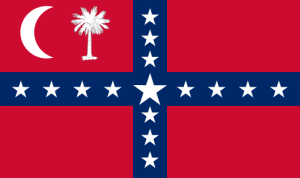The Sovereignty or Secession Flag
At the First Battle of Manassas, near Manassas, Virginia, the similarity between the “Stars and Bars” and the “Stars and Stripes” caused confusion and military problems. Regiments carried flags to help commanders observe and assess battles in the warfare of the era. At a distance, the two national flags were hard to tell apart. In addition, Confederate regiments carried many other flags, which added to the possibility of confusion. After the battle, General P.G.T. Beauregard wrote that he was “resolved then to have [our flag] changed if possible, or to adopt for my command a ‘Battle flag’, which would be Entirely different from any State or Federal flag.” He turned to his aide, who happened to be William Porcher Miles, the former chairman of the Confederate Congress’s “Committee on the Flag and Seal”. Miles described his rejected national flag design to Beauregard. Miles also told the Committee on the Flag and Seal about the general’s complaints and request for the national flag to be changed. The committee rejected this idea by a four to one vote, after which Beauregard proposed the idea of having two flags. He described the idea in a letter to his commanding General Joseph E. Johnston: “I wrote to [Miles] that we should have “two” flags—a peace or parade flag, and a war flag to be used only on the field of battle—but congress having adjourned no action will be taken on the matter—How would it do us to address the War Dept. on the subject of Regimental or badge flags made of red with two blue bars crossing each other diagonally on which shall be introduced the stars, … We would then on the field of battle know our friends from our Enemies.”
He described the idea in a letter to his commanding General Joseph E. Johnston: “I wrote to [Miles] that we should have “two” flags—a peace or parade flag, and a war flag to be used only on the field of battle—but congress having adjourned no action will be taken on the matter—How would it do us to address the War Dept. on the subject of Regimental or badge flags made of red with two blue bars crossing each other diagonally on which shall be introduced the stars, … We would then on the field of battle know our friends from our Enemies.”
The flag that Miles had favored when he was chairman of the “Committee on the Flag and Seal” eventually became the battle flag and, ultimately, the most popular flag of the Confederacy. According to historian John Coski, Miles’ design was inspired by one of the many “secessionist flags” flown at the South Carolina secession convention in Charleston of December 1860. That flag was a blue St George’s Cross (an upright or Latin cross) on a red field, with 15 white stars on the cross, representing the states honoring the secession, and, on the red field, palmetto and crescent symbols. Miles received a variety of feedback on this design, including a critique from Charles Moise, a self-described “Southerner of Jewish persuasion”. Moise liked the design, but asked that “the symbol of a particular religion not be made the symbol of the nation”.

Taking this into account, Miles changed his flag, removing the palmetto and crescent, and substituting a heraldic saltire (“X”) for the upright one. The number of stars was changed several times as well. He described these changes and his reasons for making them in early 1861. The diagonal cross was preferable, he wrote, because “it avoided the religious objection about the cross (from the Jews and many Protestant sects), because it did not stand out so conspicuously as if the cross had been placed upright thus”. He also argued that the diagonal cross was “more Heraldric [sic] than Ecclesiastical, it being the ‘saltire’ of Heraldry, and significant of strength and progress”.
